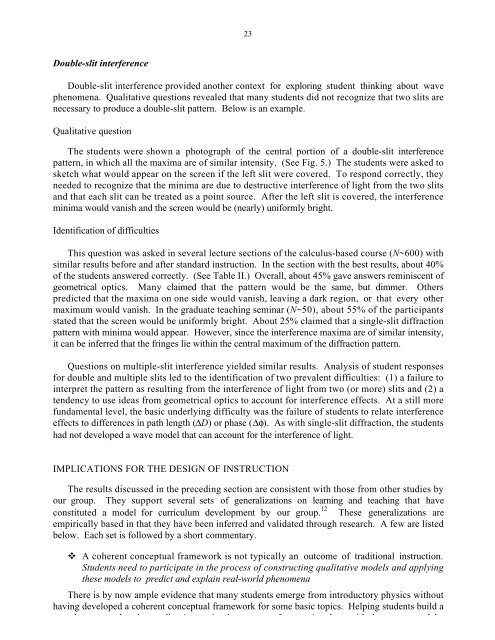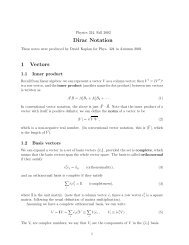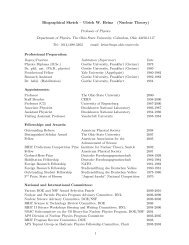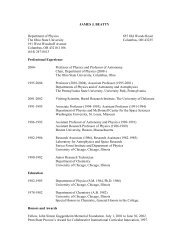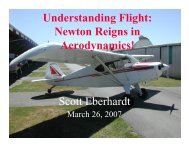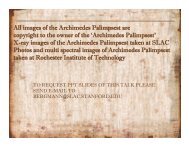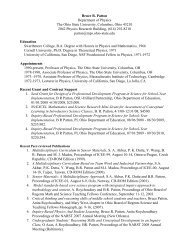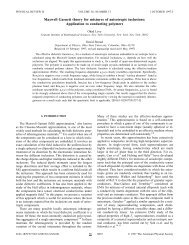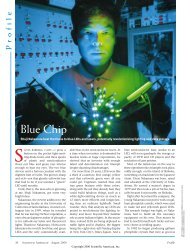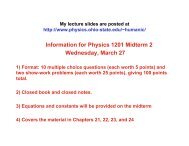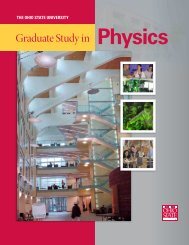Brasil Final Report - Department of Physics - The Ohio State University
Brasil Final Report - Department of Physics - The Ohio State University
Brasil Final Report - Department of Physics - The Ohio State University
You also want an ePaper? Increase the reach of your titles
YUMPU automatically turns print PDFs into web optimized ePapers that Google loves.
Double-slit interference<br />
23<br />
Double-slit interference provided another context for exploring student thinking about wave<br />
phenomena. Qualitative questions revealed that many students did not recognize that two slits are<br />
necessary to produce a double-slit pattern. Below is an example.<br />
Qualitative question<br />
<strong>The</strong> students were shown a photograph <strong>of</strong> the central portion <strong>of</strong> a double-slit interference<br />
pattern, in which all the maxima are <strong>of</strong> similar intensity. (See Fig. 5.) <strong>The</strong> students were asked to<br />
sketch what would appear on the screen if the left slit were covered. To respond correctly, they<br />
needed to recognize that the minima are due to destructive interference <strong>of</strong> light from the two slits<br />
and that each slit can be treated as a point source. After the left slit is covered, the interference<br />
minima would vanish and the screen would be (nearly) uniformly bright.<br />
Identification <strong>of</strong> difficulties<br />
This question was asked in several lecture sections <strong>of</strong> the calculus-based course (N~600) with<br />
similar results before and after standard instruction. In the section with the best results, about 40%<br />
<strong>of</strong> the students answered correctly. (See Table II.) Overall, about 45% gave answers reminiscent <strong>of</strong><br />
geometrical optics. Many claimed that the pattern would be the same, but dimmer. Others<br />
predicted that the maxima on one side would vanish, leaving a dark region, or that every other<br />
maximum would vanish. In the graduate teaching seminar (N~50), about 55% <strong>of</strong> the participants<br />
stated that the screen would be uniformly bright. About 25% claimed that a single-slit diffraction<br />
pattern with minima would appear. However, since the interference maxima are <strong>of</strong> similar intensity,<br />
it can be inferred that the fringes lie within the central maximum <strong>of</strong> the diffraction pattern.<br />
Questions on multiple-slit interference yielded similar results. Analysis <strong>of</strong> student responses<br />
for double and multiple slits led to the identification <strong>of</strong> two prevalent difficulties: (1) a failure to<br />
interpret the pattern as resulting from the interference <strong>of</strong> light from two (or more) slits and (2) a<br />
tendency to use ideas from geometrical optics to account for interference effects. At a still more<br />
fundamental level, the basic underlying difficulty was the failure <strong>of</strong> students to relate interference<br />
effects to differences in path length (ΔD) or phase (Δφ). As with single-slit diffraction, the students<br />
had not developed a wave model that can account for the interference <strong>of</strong> light.<br />
IMPLICATIONS FOR THE DESIGN OF INSTRUCTION<br />
<strong>The</strong> results discussed in the preceding section are consistent with those from other studies by<br />
our group. <strong>The</strong>y support several sets <strong>of</strong> generalizations on learning and teaching that have<br />
constituted a model for curriculum development by our group. 12 <strong>The</strong>se generalizations are<br />
empirically based in that they have been inferred and validated through research. A few are listed<br />
below. Each set is followed by a short commentary.<br />
A coherent conceptual framework is not typically an outcome <strong>of</strong> traditional instruction.<br />
Students need to participate in the process <strong>of</strong> constructing qualitative models and applying<br />
these models to predict and explain real-world phenomena<br />
<strong>The</strong>re is by now ample evidence that many students emerge from introductory physics without<br />
having developed a coherent conceptual framework for some basic topics. Helping students build a<br />
sound conceptual understanding is not simply a matter <strong>of</strong> presenting them with the proper models.


